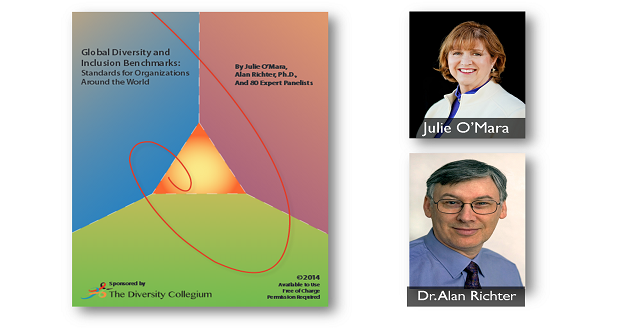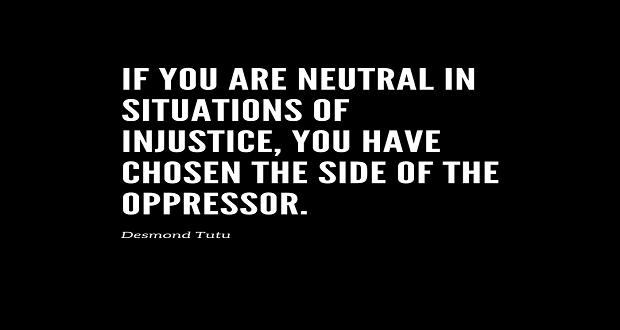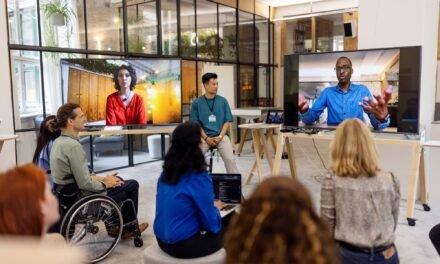
The first post in this series offered an overview of the 13 Global Diversity and Inclusion Benchmarks. Last week we focused on the foundational benchmarks. This week we will delve into the internal benchmarks and will conclude the series next week with a summary of the external benchmarks.
The four categories in this group focus on those aspects of diversity and inclusion (D&I) related to enhancing internal practices around talent attraction, development, and retention.
- Recruitment, Development, and Advancement. Describes the creation of a culture of inclusion that enhances professional excellence and supports selection, retention, and advancement. Ensures that diversity and inclusion is an important part of hiring and selection.
- Benefits, Work-Life, and Flexibility. Describes the way work is organized and the extent of flexible work arrangements. Gauges the benefits and services provided to employees to meet their needs and concerns.
- Job Design, Classification, and Compensation. Explores the way jobs are designed, classified, compensated, and assigned. Includes assessment of reward and recognition systems and how an organization is fair and equitable.
- Diversity and Inclusion Training and Education. Explore diversity and inclusion awareness, skill-building training and education, and the integration of such training into all training and development. Explores the extent to which performance improvement and training are provided equitably.
The behaviors associated with the various levels of performance on these categories are described here.
[dropshadowbox align=”none” effect=”lifted-both” width=”600px” height=”” background_color=”#c0f0f3″ border_width=”1″ border_color=”#dddddd” ]
Category 4: RECRUITMENT, DEVELOPMENT, AND ADVANCEMENT
0%
___There is no special effort to recruit, select, advance, or retain employees from underrepresented groups.
___There is a culture of assimilation that requires employees to fit into the existing culture.
25%
___The hiring focus is based on representation and meeting equal employment opportunity goals or targets.
___Firms that are contracted for recruiting are not knowledgeable about diversity recruitment and do not provide diverse slates.
___Advertising states that the organization is an equal opportunity employer, but in actuality that may not be the case.
___The majority of talent management decisions are made without consulting employees or considering employee preferences.
___Recruiting and access to training and development is not equitable.
50%
___The workforce is beginning to reflect the diversity found in the organization’s labor market, but there is still underutilization of certain groups in senior positions and some concentration of similar groups within certain functions.
___Hiring managers are educated in understanding cultural differences and the impact their biases may have on decisions.
___External search firms are selected based in part on presenting diverse slates of candidates.
___The organization offers a variety of development programs and encourages employees to take advantage of them.
75%
___Recruitment includes advertising on diversity-focused career websites, using social media, and networking with internal and external diversity groups.
___Recruitment and selection panels include the diverse population the organization wants to attract and advance.
___Employees are in their jobs based on meeting job requirements, rather than stereotypes, preferences, or traditions.
___Special efforts are made to place members of underrepresented groups in positions that serve as “feeder systems.”
___Talent management focuses on competencies, potential, and qualifications. Leaders are aware of potential bias and integrate D&I goals into talent management.
___Employees may consider development opportunities and positions outside their current functional, technical, or professional area.
___Development through self-assessment, coaching, mentoring, serving on task forces, and participating in visible projects is encouraged and open to most levels and functions.
___Employees are exposed to a variety of cultures, markets, values, and practices as part of development.
100%
___The organization’s talent development processes have resulted in equitable recruitment, retention, advancement, and a pervasive feeling of inclusion.
___The overall workforce crossing all levels and functions is generally representative of the organization’s labor markets; it manifests the perspectives and behaviors needed to serve diverse markets.
___The organization’s reputation for quality D&I efforts makes it an employer of choice, enhancing its ability to attract and retain employees who contribute to outstanding organizational results.
___Talent is developed and advanced based on competencies most needed for the organization. Doing so usually results in diverse senior leadership.
___High potential diverse talent is provided with internal coaches, mentors and external coaching opportunities to maximize performance and develop advanced careers within the organization.
[/dropshadowbox]
[dropshadowbox align=”none” effect=”lifted-both” width=”600px” height=”” background_color=”#fee3e6″ border_width=”1″ border_color=”#dddddd” ]
Category 5: BENEFITS, WORK-LIFE AND FLEXIBILITY
0%
___Only legally required employee benefits and services are provided.
___Little or no schedule flexibility or work leave is provided.
___Work schedules and workplace rules are defined based on management’s preferences and traditions of “normal” and “appropriate.”
25%
___Benefit programs are “one-size-fits-all” and their value or relevance to employees is not monitored.
___Childcare and eldercare needs are seen as an employee’s responsibility that should not interfere with work.
___Work schedules are determined by managers, and tend to be inflexible and compliance-driven. If accommodations are made, they are applied inconsistently and may be perceived as favoritism.
___There is some flexibility in allowing employees to personalize their workspaces and their dress.
50%
___The organization understands employees have responsibilities outside of work so some work-schedule flexibility, work-at-home, and part-time options are available.
___Paid leave is provided for health care, civic responsibilities, bereavement, and so forth. Unpaid leave for childcare and eldercare or emergencies is allowed. Information and referral services are available.
___Language needs and physical access are accommodated when market forces are compelling.
___Religious practices and cultural holidays are mostly accommodated even if they are not the holidays of the majority.
___Flexibility in dress and personal appearance is allowed for most employees.
___Some flexible benefits are monitored for fairness and suitability to changing conditions.
75%
___Paid leave, beyond what is legally required, is provided. This may include care giving for spouses, domestic partners, children, and adult dependents.
___Work-at-home, job-sharing, and part-time work is allowed for selected positions.
___The culture is accepting of those who work flexible schedules.
___Health and fitness benefits include education, clinics, fitness centers, employee assistance programs, and preventive care.
___Family-friendly services include subsidized childcare and eldercare (on-site or outsourced), lactation rooms, and emergency care.
___Accessibility and accommodation for people with disabilities is supported.
___Benefits and services are culturally sensitive.
___Policies and practices guard against favoritism and inconsistencies.
100%
___Leaders have the skills to respond to requests for flexibility and model work-life balance.
___Part-time, job sharing and flexible work arrangements are available for all appropriate positions. Their use, which leaders encourage, does not negatively impact career development or progress.
___The organization accepts diversity in language, dress, physical appearance, non-traditional schedules and leave, as fully legitimate.
___A full range of flexible benefits and services, including education and counseling, are provided based on employee needs, wants, and the organization’s financial ability to provide them.
___Significant others, same-sex, and transgender partners are included in organizational events that previously excluded them.
___Based on research and assessment, benefits and services are adapted to changing conditions and innovative ideas. Examples include: compensation and scheduling based on performance and results only; providing pay differentials to equalize unfair taxes; and supporting the transition of transgender employees.
[/dropshadowbox]
[dropshadowbox align=”none” effect=”lifted-both” width=”600px” height=”” background_color=”#d9f9d4″ border_width=”1″ border_color=”#dddddd” ]
Category 6: JOB DESIGN, CLASSIFICATION AND COMPENSATION
0%
___The organization lacks systematic methods for classifying jobs or determining employee compensation.
___Some jobs are thought to be “a better fit” for certain groups, based on stereotypes, such as men, younger workers, or people with disabilities.
25%
___Some written procedures exist for classifying jobs and determining compensation. However, supervisors’ personal preferences are the major determinants.
___There is a policy or guideline stating that equal pay for equal work is the norm, but the organization does not conduct an analysis to ascertain if the policy or guideline is follow
50%
___Jobs are designed to accommodate individual as well as organizational needs.
___The organization systematically reviews its job descriptions, classifications, qualifications, and compensation for obvious forms of bias and adverse impact.
___Classification/grading and compensation/ remuneration systems are widely communicated to and understood by employees.
___An analysis and design of jobs has resulted in some flexibility for some groups, such as younger workers, parents of young children, people with eldercare responsibilities, people with disabilities, or semi-retired persons.
75%
___Classification and compensation systems have been modified to address hidden biases and assumptions, and to ensure equity.
___Job requirements and descriptions are clear and not confused by non-performance factors such as style, gender, school graduated from, religion, age, or appearance preferences or traditions.
___There is increased acceptance of flexibility and variety in job design to accommodate employee needs for part-time work, working non-standard hours, and taking leave for personal or other reasons.
___The organization ensures that an annual pay gap analysis is conducted to confirm that biases based on race, age, gender, organizational function, and other potential equity issues do not reappear.
100%
___The organization has equitable compensation and classification practices.
___Innovative job design results in employees being paid for performance rather than “putting in time, “enabling them to work flexibly based on their needs and wants.
___Inequitable, past compensation systems such as gender-based pension enrollment dates that may have
resulted in current inequities have been addressed and individuals compensated.
___Reward and compensation systems have been designed specifically to reduce bias in recruiting, hiring, retention and advance the development of high-performing talent.
___For corporations, stock options and profit-sharing are offered fairly throughout the organization.
__The organization utilizes balanced scorecards or similar methods as part of its compensation system to ensure that conscious and unconscious bias is reduced.
[/dropshadowbox]
[dropshadowbox align=”none” effect=”lifted-both” width=”600px” height=”” background_color=”#d3d3d3″ border_width=”1″ border_color=”#dddddd” ]
Category 7: DIVERSITY & INCLUSION EDUCATION AND TRAINING
0%
___There is no formal D&I education or training.
___There is no obvious D&I knowledge, understanding or awareness.
25%
___Training on D&I is brief and focused on educating employees about policies and meeting legal requirements.
___Persons designing and delivering training do not have specific expertise in D&I.
___D&I training and education offered is primarily “off-the-shelf” programs not tailored for local needs and issues.
___A small resource library of diversity-related books, videos, eLearning, and other tools is available.
50%
___In addition to specific courses on D&I topics, D&I is integrated into the organization’s training and education, including employee orientation, customer service and management training.
___Programs address difficult and sometimes sensitive or uncomfortable issues of stereotypes, bias, and “isms,” and include development of skills to address those issues.
___D&I experts or training professionals design and/or conduct the D&I training; employees may be trained to help conduct some sessions.
___Instructor guides or tool kits are provided to supervisors and managers with the expectation that they conduct training and education as part of their responsibilities.
___The organization encourages cultural celebrations and organization-wide activities that combine social interaction with D&I learning and are attended
75%
___In addition to general D&I training, employees receive training specific to their level and areas of responsibility.
___Some training and education is available to members of specific groups, such as women, younger workers, and those who do not speak the dominant language of the organization. However, it is not assumed that all members of those groups need or desire that special training and education.
___D&I professionals, experts in learning methods and cross-cultural education, organizational leaders, and representatives of various stakeholders are involved in the development, delivery, and reinforcement of D&I training and education.
___D&I training and education is required for all employees and leaders.
___A variety of learning methods are used, including classroom, self-study, experiential, eLearning, assessment, videos, and case studies.
___Programs focused on specific dimensions of diversity such as disability, gender and gender identity, sexual orientation, social class, generations, culture, and ethnicity are offered and sometimes required.
___Employees and their families receive cultural competency training and other support when relocating internationally.
100%
___D&I training and education includes learning reinforcement, application and sustainability strategies.
___D&I training and education is an on-going, multi-year, developmental curriculum that takes individuals through graduated stages of learning.
___Learning is customized to meet changing local situations, ensuring that it is not global at the expense of local or local at the expense of global relevance.
___A variety of innovative D&I tools, including an extensive library, are accessible to all, fully supported, and shared externally.
___D&I is integrated into all training and education and advances the organization’s strategy. Leaders have knowledge and skills needed to demonstrate D&I behaviors and competencies.
___Challenging and sometimes controversial issues such as racism, sexism, ageism, classism, homophobia, religious bias, and unconscious bias are addressed with sensitivity, conviction, and compassion.
[/dropshadowbox]
Where does your organization stand on these internal benchmarks? Can you say you are mostly at best practice or mostly at 0%?


















